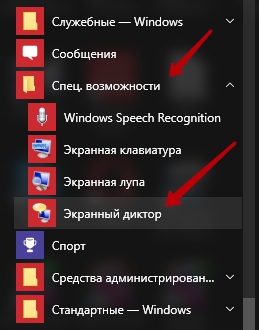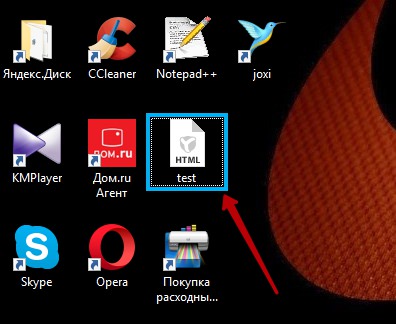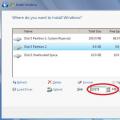How to disable Narrator. Narrator to read text aloud
Family operating system Windows already It has been supplied with a decent set of standard programs for several years, for example, MS Paint, Tweak UI, Calc, etc. Almost any program can be disabled, and Narrator is no exception.
Sponsored by P&G Placement Related articles "How to turn off Narrator" How to change the splash screen on your computer How to turn on the virtual keyboard How to display the keyboard on the monitor
Instruction
In addition to the programs mentioned above, as part of Windows systems, there are those that act as additional assistants, for example, Narrator. Its task is to read the text displayed on the screen or loaded by you into the program via the clipboard. For complete shutdown this utility, you need to run it, i.e. display on the screen, because the program works in background. On operating systems Windows versions Seven and Windows Vista, you need to click the Start menu and type Narrator in the bottom search bar. In the search results, select Narrator or press Enter. In the window that opens, select the item "Launch Control narrator when I log in" and uncheck "Turn on Narrator" and "Turn on audio description". Click the "Apply" button to save the changes. For older operating systems, this action can be performed through the Start menu. To do this, go to the "Standard Programs" section. In the Ease of Access list, find Ease of Access Center and launch it. In the window that appears, go to the "Using a computer without a screen" block and uncheck the box "Enable Narrator". After restarting your computer, you should be able to watch Narrator no longer launch. To check, launch the Task Manager application and go to the Processes tab. If this process is still active, then it is in the startup list. Press the key combination Win + R and in the empty field enter the command msconfig. Click the OK button to launch the System Configuration applet. Navigate to the Startup tab and uncheck Narrator application. To save the results and close the current window, click the Apply and Restart buttons. How simple
Other related news:
Language bar in operating systems of the Windows family, it is used to switch layouts by pressing the Ctrl + Shift or Alt + Shift key combination. But sometimes this panel disappears due to accidental deletion or system failures. You will need File Download Recovery
Most programs, including the operating system itself, produce automatic updates in the background, copying to HDD large file sizes. In some cases, this operation may delay the progress of other programs, so you can turn it off. You will need customization
To ensure high security of connections via a wired or wireless connection, it is necessary to enable support for authentication (checking) authentication. With its help, it is possible to restrict access to your connection to other devices. You will need Work with the component
To find and fix the causes of problems that are expressed in the appearance of error messages, you will need Windows startup Vista or Windows 7 using a minimal set of drivers and automatically loaded programs, referred to as a "clean boot". P&G Placement Sponsor Related Articles
Most likely every user operating system Windows knows about the existence of keyboard shortcuts and their purpose. Not all keyboard shortcuts are meant to be pressed quickly. Three key combinations are not very convenient to use. To make it easier to press 2 or more buttons at the same time, you can
When the operating system is loaded, some applications are launched, the shortcuts of which are in the startup list. You can add absolutely any application to this list. For some users, the news about the existence of such a list (autoload file) will be very useful, because. from
The operating systems of the Windows family have software complexes, which are launched automatically, i.e. without user intervention. Some of them are in the startup list, they are quite easy to remove. It is much more difficult to block the automatic launch of programs that are not in
The Narrator feature is disabled by default in Windows 10, it is rarely used by anyone, because a significant part of users are not even aware of the presence of such a feature in the new OS. Today we will look at how to enable and disable Narrator on Windows 10, all of a sudden someone needs this option, or vice versa, somehow the tool was activated, but it is absolutely not needed.
Most often, disabling the speaker is required in cases where, after the next start of the operating system, a window pops up on the screen with information that the system requires the installation of an additional voice. It, of course, must match the current language set as the localization of the Windows 10 interface.
You can just close the window every time, and in the next dialog click on the exit icon, but this option becomes annoying after several repetitions.
Let's take a look at how to disable Narrator in Windows 10.
The tool is disabled in one of the subsections of the "Options" menu.
1. We call it by right-clicking on Start and selecting "Settings" by holding the combination Win → I or through the icon in the notification area.
2. In the menu that appears, go to the "Accessibility" section.

3. In the first tab, switch the “Narrator” switch to the “Off” position.

Here you can deactivate the option auto start Narrator and change its settings: tone of voice, reading speed, publicity of prompts and input words, cursor behavior while reading, etc.
As you can see, turning off an annoying application once and for all is quite simple.
If the program simply needs to be closed (shut down), you can use one of several options (the first one is the fastest and easiest, but we will consider the more time-consuming ones just in case).
1. Simultaneously hold down the following keys: cap lock→Esc

2. We call context menu speaker in the tray (the area of the taskbar near the watch) and select the option "Close window".

3. Open the context menu of the application through its icon in the taskbar and select "Exit".

A third-party utility (like AnVir Task Manager) will also help get rid of the program by removing the corresponding entry from the startup list.
How to turn on Narrator
It’s not often, but it still happens that after turning off the announcer, he once becomes essential tool. You can launch the application in one of the following ways.
1. Execute the "narrator" command in the "Run" window (the latter is called using the Win→R keys).

2. Enter the same command as before in the search box or write part of the program name and open it.

3. We execute "cmd" in the run line or in the command interpreter, after which we enter the "narrator" command in the opened command line and press "Enter".

Also not the best fast way, but you should check it out.
4. Execute "powershell" or run extended command line via Start.

In it, enter "narrator" and run the command with the enter key.

5. Let's use the shortcut in Start.
Open the menu and expand the list of applications installed on the PC. In the special group Opportunities, click on the Narrator icon.

6. We call the Parameters, as before, for example, through Win → I. In the accessibility section, move the first switch to the “On” position.

Open the Control Panel through Win → X and go to the "Ease of Access Center", where we click on "Turn on Narrator".

 Enable Narrator
Enable Narrator
We continue to analyze the special features on Windows computer 10. Today we will talk about the Narrator feature. Function given few people know and few people use it, simply because there is no special need for it. Narrator will announce everything you do on your computer. For example, if you highlight any shortcut on your desktop, that is, click on it, Narrator announces the name of the shortcut. Or, if you press the right arrow button, Narrator will say “Right arrow.” To open Narrator, click the Start button in the lower left corner of the screen. In the window that opens, click on the tab - All applications.
In the list of all applications, at the very bottom, find the tab Special abilities and open it. In the list that opens, click on the tab - Narrator.

Next, Narrator will open. You will see a window with a blue border on your screen. Using the mouse cursor, you can select items on the screen, which will be marked with a blue border and will be spoken by the screen reader. Also, Narrator will follow all your actions on the computer and will speak them out.

Opening a folder or file, entering text, and other actions will be announced by the screen reader. Here is such an interesting feature that may be useful to someone. You can use Narrator for a variety of purposes, such as voice-over video or audio files. In general, you can think of something, the main thing is to experiment!
Screen reader for reading text aloud touch control, keyboard control. Narrator is a tool that helps people who are blind, visually impaired, or simply have trouble reading from a monitor. This feature reads text as well as other elements on your screen aloud when you mouse over, touch, or click them. It also reads text on panels such as websites and warnings. windows messages. The element being read is highlighted with a blue box. This makes it easier for visually impaired people to keep track of what they read. Narrator is easiest to turn on by pressing Windows key, on the Start screen, then All apps - Accessibility - Narrator.
In the settings of the announcer, it is possible to set it to launch directly when you log into your system. For the convenience of managing the speaker, there are a significant number of key combinations. A complete list of them at any time can be displayed by pressing the key combination Caps Lock + F1. Most Narrator commands use the Caps Lock key, as it is rarely used for other purposes. While Narrator is running to write capital letters you must use the Shift key.
A definite improvement to Narrator in Windows 8.1 is the ability to slow down or speed up Narrator's speech. In chapter " Speech”, Narrator settings, there is a slider with which you can adjust the speech speed, by default it is set to 50 percent; voice volume, by default set to maximum; and tone of voice, set to 50 percent. You can also select the voice of the screen reader. Commands for reading websites have been expanded to ensure that most elements on a web page are read aloud.
If you are using a speaker on touch screen, to read all the text, just swipe the screen, to read a specific item, tap it. Additional tools are available for fine-grained control of Narrator:
- stop Narrator; tap with one or two fingers
- read the entire current window; swipe with three fingers
- cry; double tap
- double click; triple tap
- show or hide Narrator; tap with four fingers
- move to the next or previous element; swipe left or right
- dragging an element; tap with three fingers
- scroll window; swipe up, down, left or right
- tab forward and backward; swipe left or right with three fingers.
Additional controls are available for using Narrator on the website, such as moving your finger up and down to hear the following phrases. Here's what they mean:
- heading, reads heading and highlights previous/next, swipe left/right.
- element, reads the element and highlights the previous or next on the page, swipe left/right.
- paragraph, reads the paragraph and highlights the previous or next, swipe left/right.
- line, reads a line and highlights the previous or next line of text, finger left/right.
- word, reads the word and highlights the previous or next word, swipe left/right.
- character, reads the character and highlights the previous or next character of the text, swipe left/right.
- table, reads the table and highlights the previous or next table on the website, swipe left/right.
- link, reads the link and highlights the previous or next link on the page, swipe left/right. Follow a link with a double tap.
Keyboard control of Narrator.
If you use Narrator with a keyboard, it also has its own controls.
- click on the selected element; space or Enter
- moving the cursor around the screen; Tab + cursor keys
- read paragraph; Cap Lock + D
- read the entire document; Cap Lock + H
- read the last element; Cap Lock + V
- read the whole window; Cap Lock + W
- move to the previous/next item; Caps Lock + cursor left or right
- volume control; Caps Lock + Page Up or Page Down
- reading speed adjustment; Caps Lock + plus (+) or minus (-)
- enable or disable Caps Lock; quickly press Caps Lock twice
- stop reading; ctrl
- Exit Narrator; Cap Lock + Esc.
Narrator can be useful not only for the visually impaired. Tired of reading text on the screen? Turn on Narrator and get on with your work.
 Preparing Your Computer Hard Drive for Windows XP Installation
Preparing Your Computer Hard Drive for Windows XP Installation How to restore the system using the Acronis image?
How to restore the system using the Acronis image? Windows 7 with uefi support
Windows 7 with uefi support